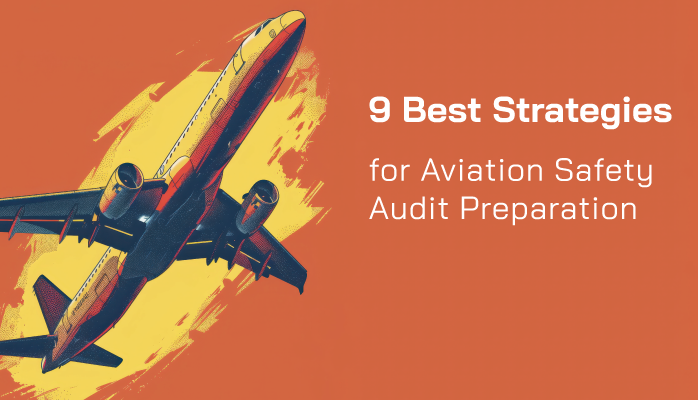Audit Performance Is 90% Aviation Safety Audit Preparation

Okay, I made up the “90%” figure. However, aviation safety audit preparation undoubtedly plays a huge role in how you perform aviation SMS audits. Considering that jobs may depend on audit performance, passing them is extremely critical. But you already know this.
Nonetheless when aviation SMS auditors are coming – and the stress level rises – it’s not always easy to prioritize getting prepared.
So much of audit preparation is going depend simply on your ability to know how to prepare.
So here are the 9 best strategies for aviation safety audit preparation, including free checklists down at the bottom.
Related Articles on Aviation SMS Auditing
- How to Create an Aviation SMS Audit Plan
- How to Think Like an Aviation SMS Auditor
- Aviation Safety Audits 101: Prep and Pass
1 – Gather Aviation SMS Audit Resources
Aviation SMS audit resources and other tools will be of invaluable help as you prepare for your aviation safety audit. A great strategy is – before you do anything else – to gather helpful resources, such as:
- Gather established guidelines from your oversight agency, such as the FAA , Transport Canada , EASA , IS-BAO , or IATA ;
- Acquire aviation SMS audit checklists;
- SMS Audit workflows; and
- SMS tools to conduct internal audits and gap analysis.
Getting the right resources will make a huge difference in your ability to prepare and perform well on audits without driving your stress level through the roof – they should be your roadmap to success.
If you don't have a checklist for a particular audit, ask your auditor for a copy of his/her audit checklist protocols. You cannot expect an SMS auditor to come to your company without giving you time to prepare. His checklist will specifically identify the general areas and specific elements under scrutiny.
Having an audit checklist will not guarantee success, i.e., no audit findings. Auditors are human and they bring with them their own interpretation of the checklists based on:
- Their operational background;
- Training;
- Their organizational objectives (such as focusing on a particular audit area); and
- Their mood (how is it going at home for them).
While the audit checklist will not guarantee smooth sailing, you can imagine the audit without any preparation. Unless you have a used car salesman's gift of gab with smoke and mirrors, it is recommended that you get the checklist and familiarize yourself well with the content.
2 – Conduct an Internal SMS Audit

In addition to gathering resources, you need to get an idea of how your SMS will perform on audits beforehand, and thus what you need to improve before the actual audit. This is what internal SMS audits are for. Unlike external audits, internal auditors work for you and should be evaluating your aviation SMS with similar standards to those of your upcoming audit. From them, you should learn:
- Where your SMS is/isn’t performing as expected;
- The most critical areas of the SMS to work on; and
- What the external audit is going to nail you for.
3 – Review Your Last Safety Audit’s Findings
Assuming this isn’t your first audit, internal audits play a valuable role in giving you a continuation point from your previous audit. By comparing your internal audit to your last external audit, you ideally will be able to see how well your SMS responded to the last audit.
Demonstrating continuous improvement in regards to audits is extremely important. Doing your homework ahead of time and being able to show the auditor exactly how you responded to previous findings will look very good for your company. Continuous improvement of the SMS is the third element of the Safety Assurance pillar. If your SMS is over three years old, then you had to be prepared to demonstrate continuous improvement with data, such as
- KPI monitoring results;
- Recent audit findings and their corrective actions;
- Lessons learned;
- Safety surveys; and
- Proof of monitoring contractors or vendors for SMS.
Related Articles on Aviation SMS Continuous Improvement
- What Continuous Improvement Compliance Looks Like in Aviation SMS
- 4 Pillars | The Truth About SMS Continuous Improvement and KPIs - With Free KPI Resources
- How to Be Compliant With Continuous Improvement of SMS
4 – Facilitate Corrective Preventative Actions to Address Previous Audit
Chances are there were findings from a previous external audit that your SMS hasn’t adequately addressed. These items are now a priority, and tasks need to be delegated so that department heads and employees can carry out the corrective preventative actions (CPAs) to address the previous audit findings.
Aviation safety audits are designed to be helpful guideposts for improving the strength of your aviation SMS. Therefore, findings are not necessarily “bad,” BUT there’s really little excuse for being hit with the same finding twice in a row.
5 – Update Any Dated Procedures

In a perfect SMS, a company's procedures would be reviewed and updated with regularity. But no SMS is perfect, and a few things will inevitably fall through the cracks. Specifically, with the amount of SMS documentation required to successfully implement, monitor and continuously improve the aviation SMS, you can expect that policies and procedures are not 100% accurate with current practices and requirements.
Safety audits are a great excuse to review and update your procedures and policies. You can also check to make sure:
- Documented safety policies and procedures are thorough; but
- That documents don't list every single activity; because
- There are always exceptions for how things are done, and being too detailed cannot possibly account for all of an operator’s exceptions to the rule.
"Exceptions to the rule" are what commonly trip up safety teams in SMS audits. For example, when your risk management processes don't align with what you do in every treatment of reported safety issues, this is an opportunity for an audit finding. If you say that you are going to perform an investigation on every issue, then provide some general guidelines as to what the process will be for an investigation.
This is a very common area where we see aviation service providers receive audit findings since we are at this point. More than once, we have seen clients fall into this trap. Depending on your risk management tools, you may have different processes for the level of investigatory procedures taken on reported safety issues of varying risk levels.
Not all reported safety issues require in-depth investigations. Sure, every reported concern should be reviewed and investigated, but what is the process for each risk level, such as
- Tolerable risk;
- Mitigable risk; and
- Intolerable risk.
Long story short, get your policies and procedures in order before the audit.
Related Articles on Reviewing Policies and Procedures
- How to Review Your Aviation Safety Risk Management Procedures
- How to Review Aviation Safety Policies for SMS - Free Checklist
- How to Know if Your Aviation Safety Policy Is Complete
6 – Organize Documentation and Have It Ready
Organizing your documentation into important, easy-to-navigate categories will make your auditor's job a whole lot easier, and will demonstrate that your SMS is “on top of it.” Things like
- Hazard register reports;
- Safety training documentation;
- Safety goals and objectives;
- Safety policy and documentation;
- Key performance monitoring activities;
- Safety meetings and communication activities; and
- Safety promotional activities.
A best practice is to organize them in the order you can expect your SMS auditor to follow through with his/her SMS audit checklist.
7 – Clean Up Your Aviation SMS Database

Chances are that it has been a while since your last audit, your aviation SMS database needs a little house cleaning. Look for things like
- a messy hazard register,
- list of grossly overdue safety reports,
- safety policies and procedures that require review, etc.,
An SMS database full of duplicate records and loose ends will not look good. Cleaning up your SMS database usually simply involves:
- Verifying that there are no overdue or “forgotten” issues to be managed;
- Ensuring that there are no duplicate entries; and
- Quickly making sure that your managed safety issues contain all of the critical information an auditor would be interested to see.
This is a process that doesn’t take much time, and if you do it an auditor may not even notice – but if you don’t do it, it will stick out like a sore thumb.
Related Aviation SMS Database Articles
- What Is an Aviation Safety Database
- How to Choose the Best Aviation Safety Database Software
- How to Manage Aviation SMS Without Complex SMS Databases
8 – Ensure Employees Know Their Duties Based on Company Policy
Employees should be informed about the ensuing safety audit and should also review the language of their role in the safety program, as described in your SMS documentation.
On the one hand, not only does this demonstrate to auditors that your roles and responsibilities are current, but it gives employees confidence by providing language to lean on should the auditor confront them.
9 – Gather Visual Charts Do Demonstrate Your Performance
Visual data is almost always the most impressive kind. While, to my understanding, you are under no requirement to provide visual data about various aspects of your program, presenting the most relevant data (such as KPI charts) in visual form will undoubtedly make a much stronger impression on auditors than simple numbers.
SMS performance tracking charts can come in many flavors, including
- Key performance indicator performance;
- Company Reporting culture;
- Responsiveness of issue closure;
- Risk severity breakdown of reported issues;
- And so on.
Basically, good visual charts should demonstrate your continuous improvement.
If you are expecting an audit, or would like to proactively prepare for an audit, here are four audit checklists to provide guidance. Good luck.
Last updated in December 2024.






